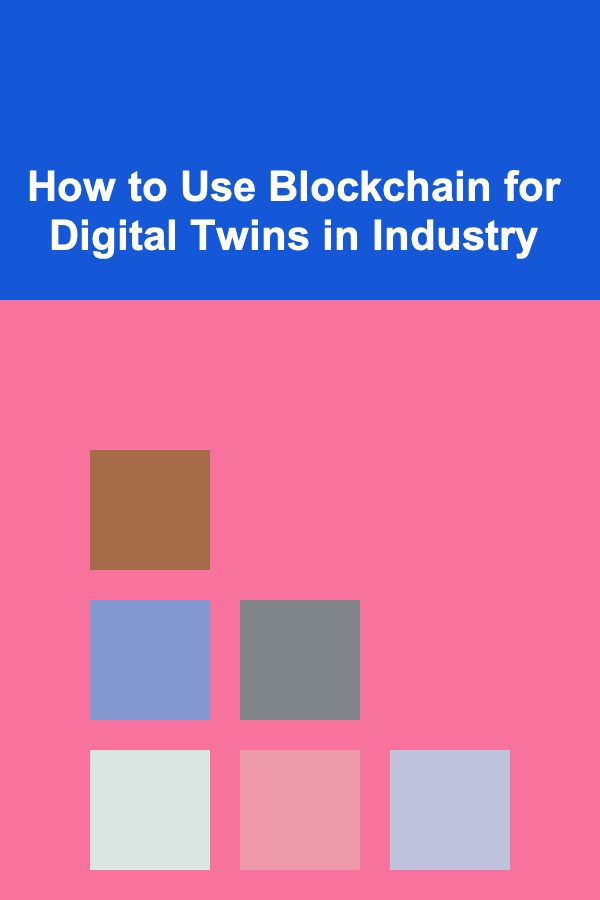
How to Use Blockchain for Digital Twins in Industry
ebook include PDF & Audio bundle (Micro Guide)
$12.99$7.99
Limited Time Offer! Order within the next:

In the rapidly advancing technological landscape, the convergence of emerging technologies like blockchain and digital twins holds immense potential to revolutionize industries. Digital twins are virtual representations of physical objects, processes, or systems, which can be used to monitor, simulate, and analyze their real-world counterparts in real-time. Blockchain, on the other hand, provides a decentralized and immutable ledger technology that ensures transparency, security, and accountability. When integrated, blockchain and digital twins can significantly enhance the way industries operate, improving efficiency, reducing costs, and ensuring data integrity.
This article explores how blockchain can be used to enhance digital twin technology in various industrial sectors. It outlines the benefits, challenges, and potential applications of this powerful combination, focusing on how blockchain addresses the key challenges of data security, interoperability, and trust in digital twin environments.
What Are Digital Twins?
A digital twin is a digital replica of a physical entity, whether that's a product, system, or process. It involves capturing and analyzing data from real-world assets using sensors and IoT devices. This data is then processed and used to create a virtual model that reflects the real-world behavior and performance of the asset. Digital twins are primarily used for monitoring, predictive analytics, and optimization.
Key Features of Digital Twins:
- Real-time Monitoring: Digital twins enable continuous monitoring of physical assets in real-time, capturing data on temperature, pressure, humidity, and other relevant metrics.
- Simulation and Predictive Analysis: By analyzing historical data and using machine learning algorithms, digital twins can simulate future scenarios and predict potential failures or maintenance needs.
- Optimization: Using data-driven insights, digital twins allow businesses to optimize processes, enhance product designs, and improve operational efficiency.
While digital twins have tremendous potential, they face challenges related to data security, scalability, and trust, especially when dealing with sensitive industrial data. This is where blockchain comes into play.
What Is Blockchain?
Blockchain is a decentralized and distributed ledger technology that ensures secure, transparent, and tamper-proof transactions. At its core, blockchain stores data in blocks, with each block containing a list of transactions that are linked together in chronological order. Once data is added to the blockchain, it is nearly impossible to alter, providing a high level of data integrity.
Blockchain's main features include:
- Decentralization: No central authority controls the blockchain, making it more resilient and less susceptible to hacking or manipulation.
- Immutability: Once data is added to the blockchain, it cannot be changed or deleted, ensuring the integrity of the data.
- Transparency: All transactions on the blockchain are publicly available and can be audited by anyone with access to the network.
- Security: Blockchain uses advanced cryptographic techniques to ensure the security of data, preventing unauthorized access or modifications.
Blockchain has found applications in various industries, including finance, supply chain, healthcare, and logistics. When applied to digital twins, it can enhance the technology by providing a secure and transparent platform for storing and sharing data.
The Intersection of Blockchain and Digital Twins
Combining blockchain with digital twin technology brings several benefits to industries that rely on real-time data, such as manufacturing, energy, and healthcare. Blockchain offers a solution to some of the critical challenges that digital twins face, particularly concerning data security, transparency, and interoperability.
1. Enhanced Data Security and Privacy
One of the primary concerns in the digital twin ecosystem is data security. Digital twins rely on data collected from IoT devices and sensors, which can be vulnerable to hacking or manipulation. By using blockchain, data integrity can be guaranteed, as any changes to the data are recorded in an immutable ledger.
Blockchain ensures that only authorized parties can access or modify the data related to digital twins. This is particularly important in industries such as healthcare and finance, where sensitive information must be protected.
Example: Digital Twins in Healthcare
In the healthcare industry, digital twins are used to model patients' health profiles, providing personalized treatments and predictive analytics. Blockchain can ensure that the data about a patient's medical history, genetic information, and treatment plans are secure and only accessible by authorized medical professionals. This provides patients with control over their data while ensuring privacy and trust between parties.
2. Improved Data Integrity and Trust
The decentralization of blockchain ensures that no single entity controls the data, creating a system where data can be independently verified. In digital twin applications, where large amounts of data are generated from multiple sources, blockchain provides an efficient method of ensuring data consistency and integrity.
By using blockchain, all stakeholders involved in the digital twin ecosystem---such as manufacturers, service providers, and end-users---can trust that the data is accurate and authentic. This eliminates the need for intermediaries to verify data, reducing overhead costs and streamlining operations.
Example: Digital Twins in Manufacturing
In the manufacturing industry, blockchain can be used to track the lifecycle of products represented by digital twins. For example, a digital twin of a machine can record maintenance activities, spare part replacements, and performance data. Blockchain guarantees that the maintenance logs cannot be altered or deleted, ensuring the accuracy of the machine's service history. This builds trust with customers, as they can verify the product's authenticity and performance before making a purchase.
3. Interoperability and Integration
Digital twins often rely on data from multiple sources and devices, each using different protocols and standards. Blockchain can help address the interoperability challenges of integrating data from disparate systems, creating a unified platform for sharing information.
Blockchain's decentralized nature allows different organizations to participate in the digital twin ecosystem without the need for a central authority to govern interactions. This enables seamless data exchange between parties, regardless of their technical infrastructure.
Example: Digital Twins in the Supply Chain
In the supply chain industry, blockchain can enable the integration of data from multiple suppliers, logistics providers, and customers. Digital twins can represent products as they move through the supply chain, providing real-time visibility into the status of goods. Blockchain ensures that all parties involved in the supply chain have access to the same data, enabling better coordination and reducing the risk of errors or fraud.
4. Smart Contracts and Automation
Blockchain's smart contract capabilities enable automation within the digital twin ecosystem. Smart contracts are self-executing contracts with the terms of the agreement directly written into code. These contracts can automatically trigger actions based on predefined conditions, eliminating the need for manual intervention.
In digital twin applications, smart contracts can automate various processes, such as triggering maintenance when a machine's performance drops below a certain threshold or releasing payments when specific conditions are met in a supply chain.
Example: Digital Twins in Energy
In the energy sector, digital twins can be used to model power grids, optimizing energy distribution and consumption. Blockchain-based smart contracts can automatically adjust energy flow based on demand, ensuring the grid operates efficiently. For instance, a smart contract could be programmed to buy and sell energy based on the prices and energy usage patterns captured by digital twins, ensuring a more efficient and transparent energy market.
5. Supply Chain and Asset Tracking
Blockchain and digital twins can play a significant role in improving asset tracking and monitoring in industries such as logistics, manufacturing, and retail. By combining blockchain's ability to securely track ownership and transactions with digital twins' ability to simulate and monitor assets in real-time, industries can gain a deeper understanding of their operations and reduce inefficiencies.
Example: Digital Twins in Retail
In the retail industry, digital twins can represent products as they move through the supply chain, providing real-time data on stock levels, location, and condition. Blockchain can be used to track the ownership and transaction history of each product, ensuring that customers receive authentic products and that retailers can verify the provenance of their goods. This reduces the risk of counterfeit products and increases transparency in the retail supply chain.
Challenges of Using Blockchain with Digital Twins
While the combination of blockchain and digital twins offers numerous advantages, there are also challenges that need to be addressed for successful implementation.
1. Scalability
The scalability of blockchain networks can be a concern, especially when dealing with the massive amounts of data generated by digital twins in industrial environments. Traditional blockchain networks, such as Bitcoin or Ethereum, may not be able to handle the volume of transactions required in real-time digital twin applications. Solutions such as layer-two scaling, sharding, and private blockchains are being explored to address these issues.
2. Complexity and Integration
Integrating blockchain into existing digital twin systems can be complex, requiring significant changes to the underlying infrastructure. Organizations may need to invest in new technologies and tools to ensure seamless integration. Additionally, training employees and stakeholders to understand blockchain and digital twin concepts can be a time-consuming process.
3. Energy Consumption
Blockchain networks, particularly proof-of-work-based systems, consume large amounts of energy. As digital twin applications scale and more data is added to the blockchain, the energy consumption may increase significantly. While solutions like proof-of-stake are being developed to address energy concerns, this remains an area of focus for future advancements.
Conclusion
The integration of blockchain and digital twins has the potential to revolutionize industries by improving data security, enhancing trust, enabling automation, and increasing transparency. As industries continue to adopt digital twin technology, the addition of blockchain will address some of the key challenges related to data integrity, interoperability, and security. However, the successful implementation of this technology will require overcoming scalability, integration, and energy consumption challenges.
By leveraging the strengths of both blockchain and digital twins, industries can unlock new opportunities for optimization, innovation, and efficiency, paving the way for a more connected and transparent future.

How to Make Money Online as an Email Marketing Manager: 10 Actionable Ideas
Read More
How to Regularly Inspect and Maintain Your Home's Smoke Detectors
Read More
Smart Strategies for Finding Hidden Gems While Shopping Sales and Clearance Racks
Read More
Top Tips for Utilizing Free Community Events and Activities for Family Fun
Read More
How to Build Educational Robotics Kits: A Deep Dive
Read More
Crafting Exquisite Non-Alcoholic Coffee Beverages
Read MoreOther Products

How to Make Money Online as an Email Marketing Manager: 10 Actionable Ideas
Read More
How to Regularly Inspect and Maintain Your Home's Smoke Detectors
Read More
Smart Strategies for Finding Hidden Gems While Shopping Sales and Clearance Racks
Read More
Top Tips for Utilizing Free Community Events and Activities for Family Fun
Read More
How to Build Educational Robotics Kits: A Deep Dive
Read More